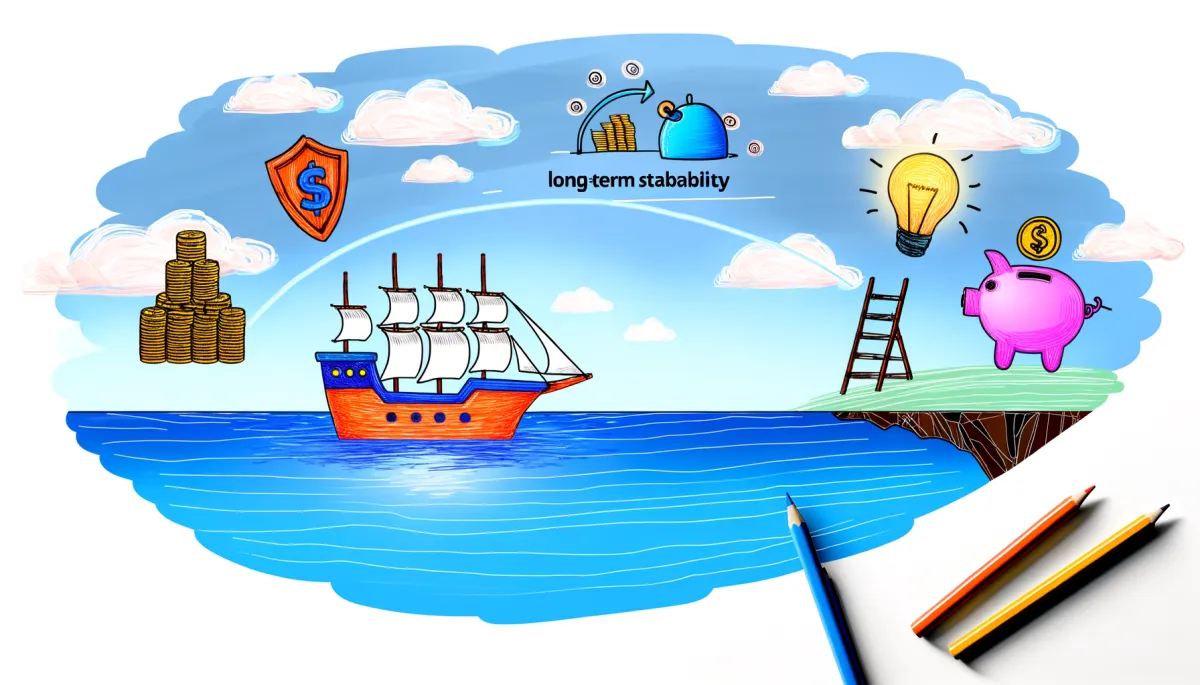
Ensuring long-term stability in freelancing: The ultimate guide to savings, insurance, and upskilling
Freelancing offers immense freedom and flexibility. But with that comes a certain level of risk and unpredictability. Finding sustained success in the freelance world is about understanding these challenges and taking proactive steps to safeguard against them. As a freelancer, it’s essential to focus on long-term stability in freelancing through savings, insurance, and upskilling.

But how can you achieve that stability and what steps should you take? This article guides you through key steps that will help you to ensure long-term stability in freelancing. With an emphasis on savings, insurance, and continuous skills development, we aim to equip you with the necessary knowledge to thrive as a freelancer.
Introduction
Long-term stability in freelancing means having a steady income, financial security, and the ability to weather dry spells without panic. It’s about creating a career that’s not just surviving but sustainable—one that doesn’t collapse if a client disappears or a surprise bill shows up.
As freelancers, we don’t get company benefits. No guaranteed paycheck, no built-in health insurance, no matching 401(k)s. That means we have to build our own safety nets. This is where savings, insurance, and upskilling come in.
Savings give you breathing room when payments are late or when work slows down. Insurance protects you from financial surprises—think medical emergencies or damaged equipment. And upskilling? That’s how you stay competitive, raise your rates, and keep clients coming.
None of this is about being perfect; it’s about being ready. Freelancing can be unpredictable, but with the right tools in place, you’ll be able to handle the rough patches and keep your momentum going. Think of it as building a foundation, not just flying from gig to gig.
Importance of Savings Strategy
Let’s be honest—freelancing means dry months are inevitable. One month, you’re flush. The next, you’re stretching invoices. That’s why having a smart, simple savings strategy isn’t just nice—it’s non-negotiable.
Start with the basics: aim to save at least 20–30% of every payment you receive. Tax time will always come, and so will surprise expenses—like a busted laptop or a client who ghosts mid-project. Create an emergency fund with at least 3–6 months of your baseline living expenses. This isn’t just a cushion—it’s your safety net when work slows down or life throws a curveball.
Pro tip: automate everything. Set up a separate account just for taxes. Another one for general savings. Get paid? Auto-transfer. That way, you’re not relying on willpower every time money comes in.
Want real-world savings workflows from experienced freelancers? Head over to our community at theonlineworker.com. It's full of practical insights crowdsourced from people actually living the freelance life every day.
Freelancer Insurance: Protecting Against Unforeseen Circumstances
Freelancers don’t get sick days, company-backed health plans, or paid leave. That means when life throws a curveball—illness, accidents, or even client disputes—you’re financially exposed. Insurance is your buffer. It won’t eliminate the risk, but it can minimize the damage.
Start with health insurance. It’s the most essential. In many countries, it’s mandatory, but even if it’s not, skipping it is playing with fire. A single hospital visit can wipe out months or years of savings.
Next, look into liability insurance. If you work with clients closely—especially in creative, consulting, or IT fields—you’re one miscommunication away from a lawsuit or refund request. Professional liability coverage helps protect you when clients claim your work caused them financial loss.
Don’t forget income protection or disability insurance. If injury or illness prevents you from working, this type floats your income. It’s not cheap, but if you’re the only breadwinner or have thin savings, it’s a lifeline.
Quick checklist:
✅ Health insurance
✅ Liability insurance
✅ Disability/income protection
✅ Equipment insurance (if you rely on tools, like a laptop or camera)
The goal here isn’t to overinsure—it’s to cover what really stings. Focus on the areas where one hit could seriously derail your freelance income. A bit of planning now can save you big time down the line.
Upskilling in Freelancing
Freelancing is a fast-moving train—you either stay on or get left behind. Clients expect more than just a polished portfolio; they want current, relevant skills. That’s where upskilling comes in.
Keeping your skills sharp isn’t optional—it’s survival. Whether you’re a:
Designer
Developer
Writer
Marketer
Virtual Assistant
…the tools and trends change—fast. Staying updated helps you:
Command higher rates
Attract better clients
Pivot when the market shifts
How to Approach Upskilling
🧭 Start with a Simple Strategy
Pick one skill per quarter to improve. Make it relevant to your niche—but also keep an eye on where your industry is headed.
🔄 Build It Into Your Routine
Don’t wait for a lull in client work. Make learning a regular habit.
Block time each week (even 30 minutes a day adds up)
Use slow project periods to dive into tutorials
Stay consistent rather than cramming
Go-To Resources
Here are some great platforms and tools to explore:
Coursera – University-level courses across industries
Skillshare – Creative and freelance-focused topics
LinkedIn Learning – Professional development
Automate & Scale – A book filled with tools for working smarter (available at automatescale.com)
The Bottom Line
Your future self depends on the skills you build today.
Treat upskilling as a non-negotiable part of your freelance business—not an afterthought. In a rapidly changing market, it’s not about finding time for learning—it’s about making time.

